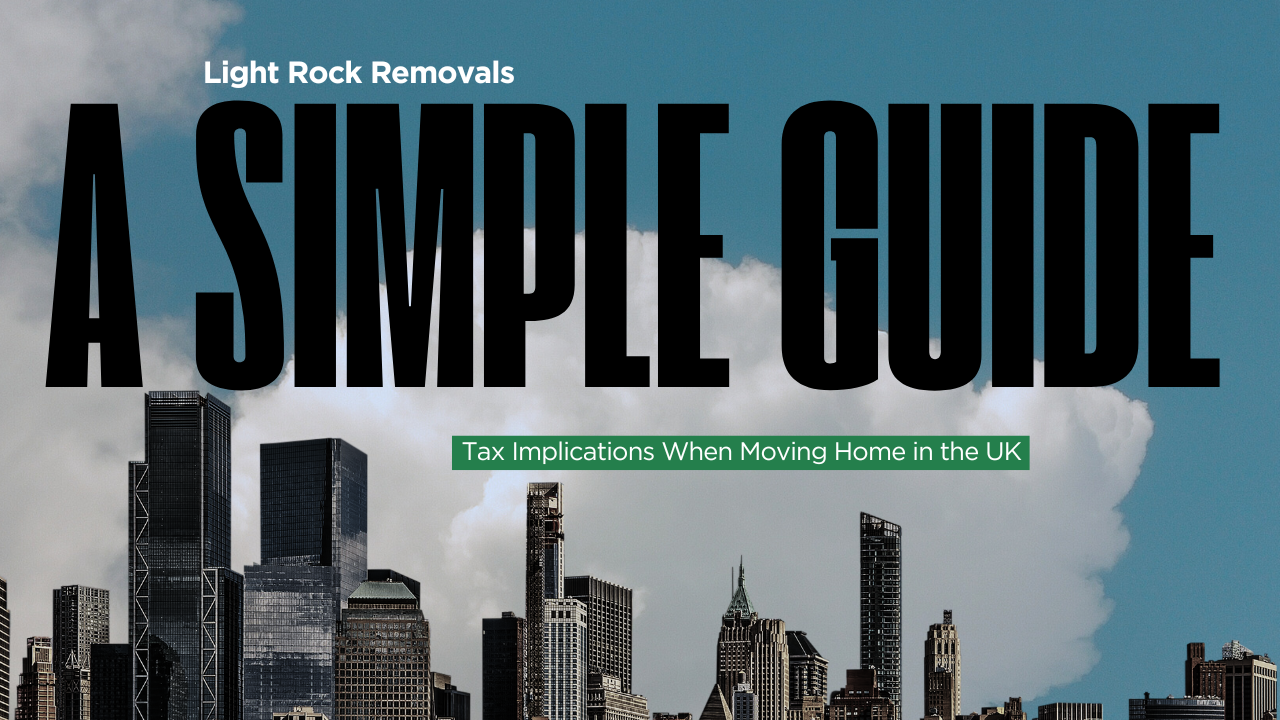Tax Implications When Moving Home in the UK: A Simple Guide
Moving home in the UK is a significant life event, and while you're focused on finding the perfect new place and packing up your belongings, it's also important to be aware of the potential tax implications involved. This guide aims to provide a simple overview of the main tax considerations for homeowners who are selling and buying property in the UK. While navigating taxes can sometimes feel complex, rest assured that Light Rock Removals offers a straightforward and transparent service for your physical move, allowing you to concentrate on these important financial aspects.

Moving home in the UK is a significant life event, and while you're focused on finding the perfect new place and packing up your belongings, it's also important to be aware of the potential tax implications involved. This guide aims to provide a simple overview of the main tax considerations for homeowners who are selling and buying property in the UK. While navigating taxes can sometimes feel complex, rest assured that Light Rock Removals offers a straightforward and transparent service for your physical move, allowing you to concentrate on these important financial aspects.
Capital Gains Tax (CGT): When it Applies to Selling a Property (Usually Not Your Main Residence)
Capital Gains Tax (CGT) is a tax on the profit, or 'gain,' you make when you sell or dispose of an asset that has increased in value. The good news for most homeowners is that you generally don't have to pay CGT when you sell your main home, thanks to a relief called Private Residence Relief (PRR). This relief applies if the property has been your only or main residence for the entire time you owned it.
However, CGT may become payable in certain circumstances when you sell a property that was once your main home, or if you are selling a property that was never your main residence. These situations include: if you have let out part of your home (excluding taking in lodgers) , if you have used a portion of your home exclusively for business purposes , if the grounds of your property are very large (over 0.5 hectares) , or if you originally bought the property with the primary intention of making a profit from its sale. Most commonly, CGT will apply when you sell a second home, a buy-to-let property, or any other property that has not been your primary residence.
For the 2024/25 tax year, the Capital Gains Tax rates on residential property are 18% for basic rate taxpayers and 24% for higher and additional rate taxpayers. Every individual has an annual Capital Gains Tax exempt amount, which for the 2024/25 tax year is £3,000. You only pay CGT on gains that exceed this amount. If you sell a UK property that is subject to CGT, you are required to report the gain and pay any tax due within 60 days of the completion of the sale.
Stamp Duty Land Tax (SDLT): How it Works When Buying a New Property in England and Northern Ireland (Mentioning Potential Differences in Scotland and Wales)
Stamp Duty Land Tax (SDLT) is a tax you usually pay when you buy a residential property in England and Northern Ireland that costs more than £125,000 (following the changes on April 1, 2025). The specific thresholds and rates depend on whether you are a first-time buyer, moving home, or buying an additional property. As of April 1, 2025, the standard nil-rate band is £125,000, and for first-time buyers, it's £300,000 for properties up to £500,000.
It's important to be aware that Scotland has its own property transaction tax called Land and Buildings Transaction Tax (LBTT), and Wales has Land Transaction Tax (LTT), both with their own sets of thresholds and rates. When buying a property, it's advisable to use an online Stamp Duty calculator to estimate the amount of tax you will need to pay.
Council Tax: Explaining How it Works When Moving Between Properties and Dealing with Refunds or New Bills
When you move home, you will need to inform both your old and new local council about your change of address. You should provide them with your moving date and a forwarding address. Your old council will then issue a final Council Tax bill, and if you have overpaid, you should receive a refund. At your new address, you will need to register for Council Tax, and the new council will send you a bill based on the property's Council Tax band. Be aware that you might be liable for Council Tax on both properties for a short period if your moving dates overlap.
Potential VAT Implications if Using Removal or Other Services (Though Typically Standard Rated)
When using removal companies or other services related to your move, such as packing services, the fees charged will typically include Value Added Tax (VAT) at the standard rate, which is currently 20% in the UK. This VAT is usually incorporated into the quoted price, so you generally do not need to calculate it separately. There are no specific VAT exemptions or special rates that typically apply to standard residential moving services.
Importance of Keeping Records Related to Moving Costs
It is essential to keep detailed records and receipts for all expenses associated with your house move. These records can include estate agent fees, solicitor fees, removal costs, Stamp Duty Land Tax, and any expenses for improvements made to your old property. These documents may be necessary for Capital Gains Tax calculations if applicable and for general financial tracking purposes.
Where to Find More Detailed Information and Professional Tax Advice
For more comprehensive information on Capital Gains Tax and Stamp Duty Land Tax, you can refer to the official GOV.UK website. Given the complexities of tax laws, it is always recommended to seek advice from a qualified tax advisor or accountant who can provide personalized guidance based on your specific circumstances. Resources like Citizens Advice can also offer general guidance on tax-related matters.
Conclusion
Moving home in the UK involves several important tax considerations, from Capital Gains Tax on the sale of a property that is not your main residence to Stamp Duty Land Tax when buying a new one, as well as managing Council Tax and understanding VAT on services. By being aware of these implications and keeping thorough records, you can navigate the tax aspects of your move more effectively. When in doubt, seeking professional tax advice is always a prudent step. Rest assured that while you are managing these financial details, Light Rock Removals is committed to providing a straightforward and efficient service for your physical relocation.
Share this on social media
Read the latest articles




